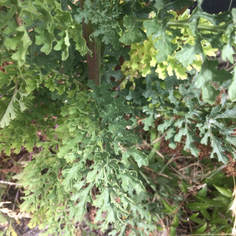Tansy Ragwort Update and a Bit of History
By Ras Sauer
Tansy Ragwort was introduced to the United States around the beginning of the 20th century (1900-1920). Brought over from Europe on Trade ships. Because of Tansy's abundance in Europe, it was often used as supplemental ballast in the ship bilges to equalize buoyancy of the older vessels, then cast off in port to make room for items returning to Europe. Reaching North American shores, Tansy Ragwort backpacked it's way to the West Coast. Everything was ideal to this new invader. The Pacific Northwest was the ideal climate and conditions to take root, and establish it's future.
Fast forward to the early ‘60's. Tansy Ragwort was identified as a toxic plant by the US Dept. of Agriculture and found responsible for the deaths of thousands of cattle and horses. (Remember, these are economic losses, so the deaths of other grazing animals would not be a factor in this designation). Spraying and mechanical removal was eventually assisted by the introduction of three insects for biological control in heavily affected areas:
- Cinnabar Moth (Tyria jacobaeae). The larva feeds on flowers and foliage. It is the most beneficial of the three, stripping the plant of the necessary material to continue through a full cycle. However, during warmer and wetter winters, the plant will again flower and seed.
- Flea Beetle (Longitarus jacobaeae): Feeds on the plant’s root system.
- Seed Head Fly (Botanophila seneciella) is less effective and feeds on the seeds.
However, a combination of fewer host plants and changing climate conditions have made the insects ineffective. And it is questionable as to whether they will breed fast enough to help in the control of the current plant explosion.
Fast forward again to 1978. I was passing through the Portland area for a second time, making some stops to see old friends, then on to Alaska, my destination. I was approached by a friend to partake in a "Tansy Pulling Party." Had not a clue what they were talking about. But music, food, and spirits were too hard to pass up on the road North. The address was 16340 NW Rock Creek Rd., the current site of Shady Springs Farm. It was then the residence of Mark Taggard (author of "Holistic Medicine"). The fields and pastures there were yellow with wildflowers, as was most of "The Hill". I was about to have my first experience with Tansy Ragwort.
From that point forward, I made "The Hill" my home, first at Rt.2, Box 330A. We raised livestock, and loved the elk, deer, our signature pygmy rabbits, and all of the other wild grazers. Tansy Ragwort became a target; not only to me, but to the entire community. Bob Benson, a local map maker and historian, distributed tens of thousands of Cinnabar caterpillars through many of us. They were distributed on both sides of the pass to Dixie Mt. on the worst fields. With the Cinnabars at work, and relentless pulling, digging, and in some cases spraying, the Hill was mostly cleared before almost any other areas I'd passed through. Nevertheless, two horses were lost, one on Elliot Rd. and one on lower Rock Creek Rd. Hopefully, we thought, it would not happen again. Over the years, the stray plants I've pulled around the Hill, on hiking paths, streams and rivers and a variety of other locations, has been minimal.
Fast forward to the present. The "Yellow Wildflower" I have so scarcely seen is returning with a vengeance. The presence of it is everywhere. At first glance, one would believe that it is an unidentified plant. It is being nurtured in our public parks, in private and public flower gardens, restaurants, roadsides, and waterways. I’m in disbelief at it's emerging abundance. And also of the thought that Tansy Ragwort is enjoying an ominous comeback to an uninformed public.
Is this an appeal for action? I suppose the answer would be yes. To walkers: carry a bag and harvest the tops along roadsides, as cars will pass the seeds for miles. To property owners: clear it from your land. Please forward information to anyone you know who is uninformed about Tansy Ragwort's lethal properties.
Thank you, Neighbors.
(RR July '17)
|
|



